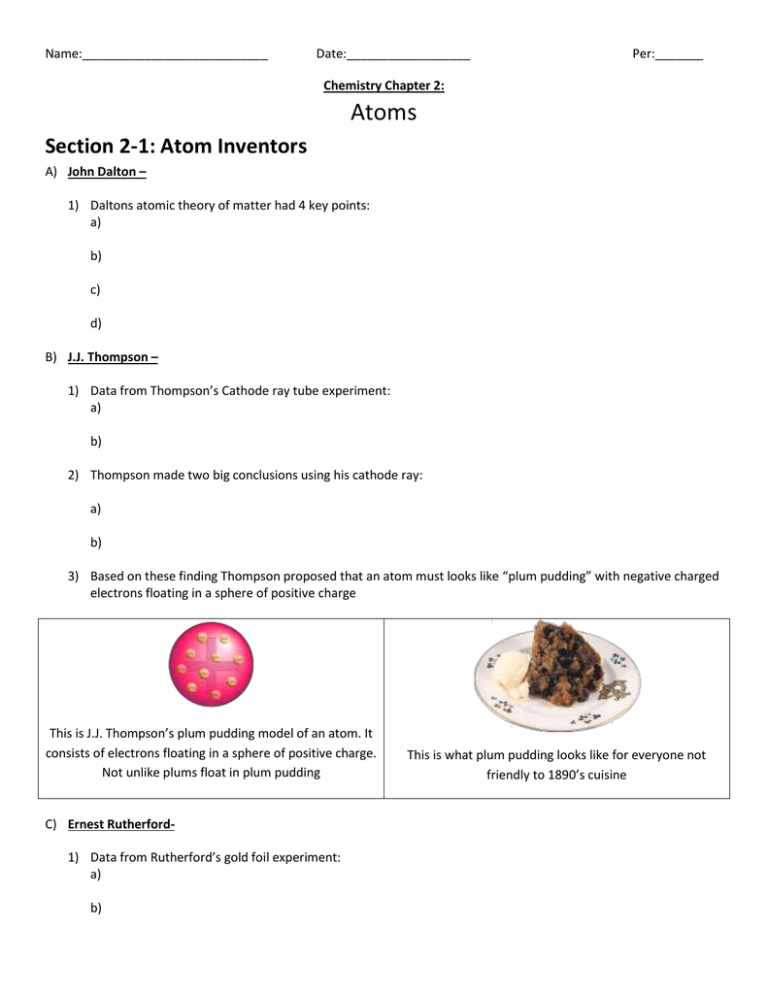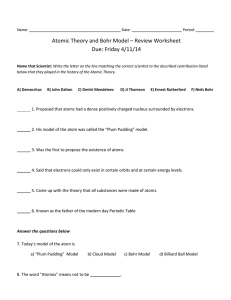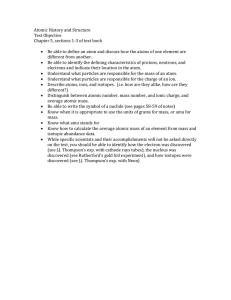Atoms Section 2-1: Atom Inventors
advertisement

Name:___________________________ Date:__________________ Per:_______ Chemistry Chapter 2: Atoms Section 2-1: Atom Inventors A) John Dalton – 1) Daltons atomic theory of matter had 4 key points: a) b) c) d) B) J.J. Thompson – 1) Data from Thompson’s Cathode ray tube experiment: a) b) 2) Thompson made two big conclusions using his cathode ray: a) b) 3) Based on these finding Thompson proposed that an atom must looks like “plum pudding” with negative charged electrons floating in a sphere of positive charge This is J.J. Thompson’s plum pudding model of an atom. It consists of electrons floating in a sphere of positive charge. Not unlike plums float in plum pudding C) Ernest Rutherford1) Data from Rutherford’s gold foil experiment: a) b) This is what plum pudding looks like for everyone not friendly to 1890’s cuisine 2) Conclusions of Rutherford gold foil experiment a) b) 3) Based on these findings Rutherford corrected Thompson’s plum pudding model of an atom saying that an atom must consist of a small dense positively charged nucleus with electrons floating in a cloud on the outside Section 2-2: Numerically describing atoms A) What is an atom made out of? 1) A atom is made out of three smaller (subatomic)particles: a) b) c) Mass (AMU) Location Charge Symbol Proton Neutron Electron B) What is the difference between one atom and another? 1) Atomic number – a) Because we aren’t getting shocked by everything we touch most atoms are neutral, meaning that they have the same number of protons and electrons 2) Mass Number (atomic mass)(I) This number is expressed in AMU’s or atomic mass units (II) 1 AMU is an extremely small unit for mass, it is only useful when describing a (i) 1 proton or neutron is about 1 AMU single atom C) What number converts atomic mass units to a useful mass? 1) 1 mole of AMUs or 6.02x1023 of AMU is 1 gram: a) 1 H atom = 1mole of H atoms = b) 1 O atom= 1mole of O atoms= c) 1 C atom= 1mole of O atoms = 2) Therefore because a mole or 6.02x1023 of AMUs 1 gram a mole of atoms is equal to its atomic mass in grams: a) 1mole of H atoms is ___________H atoms, 1mole of H atoms weighs ______ gram b) 1mole of O atoms is ___________O atoms, 1mole of O weighs ______ grams c) 1mole of C atoms is ___________ C atoms, 1mole of C weighs ______ grams 3) Molar Mass – Section 2-3: Different types of atoms D) Are there different types of atoms? 1) Atoms can have varying numbers of electrons and neutrons a) Ions (I) Atoms have a charge when the electron and proton number isn’t equal Ion Charge = b) Mg +2 = 2 more positives than negatives Atomic number (number of protons) Number of electrons Charge (p+) – (e-) c) N-3 = 3 more negatives than positives Atomic number (number of protons) Number of electrons Charge (p+) – (e-) 2) Isotopes a) All isotopes of an element have the same number of protons (atomic number is what gives the atom its identity) but the number of neutrons may vary b) Chemists represent isotopes on paper using 1 of two ways: (i) There is two different forms of isotopic notation: 1- The hyphen notation: Full name – mass number of isotope EX: 17 p+, 17 e-, and 16n0 2- Full Isotopic Notation: Atomic symbolcharge EX: 17 p , 17 e-, and 16n0 MassNumber AtomicNumber +






